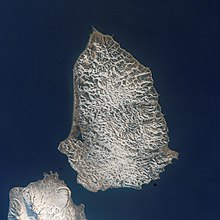Battle of Shumshu
[11] As Stalin had promised, the Soviet Union declared war against Japan on 8 August 1945, exactly three months after the capitulation of Germany, and began an offensive against Japanese forces in Northeast Asia the next day.
The area covers 230 square kilometers, with gently rolling hills at about 200 meters above sea level, consisting of marshlands and grasslands.
In fact, after the ceasefire in Sakhalin on August 22, Stalin informed Truman that he would abandon the claim to Hokkaido, but negotiations regarding airfield construction continued with the United States over the Kuril Islands.
Additionally, Brigadier General Deane mentioned in his memoir, Strange Alliance: The Story of Our Efforts to Cooperate with Russia During the War, that the Soviets suspected that the U.S. had occupied the Kuril Islands.
The division's soldiers were mostly survivors of the Nomonhan Incident and the Battle of Guadalcanal, and many had also participated in the Kiska Island evacuation operation, making them highly experienced.
Even by 1945, the main adversary that Japan expected to fight was the United States, and there were no special provisions made for preparedness against the Soviet Union.
[17] With a reduction in defensive strength, the deployment strategy shifted from a decisive battle focus to ensuring control of critical zones, with particular emphasis on blocking passage through the Horomushiro Strait.
However, the Japanese forces directly involved in the fighting on the 18th were only about 8,500 men, consisting of the three infantry battalions and one artillery company stationed around Takeda Beach, along with reinforcements.
According to the "War History Series," the Japanese strategy was to eventually deploy all forces to eliminate the enemy and then return to the dual fortress positions on Shumshu and Horomushiro Islands.
2nd Far Eastern Front Regarding the advance into southern Sakhalin and the Kuril Islands, the Soviet Navy, particularly the Pacific Fleet, was facing a shortage of warships.
Chronically poor weather in the area limited the ability of Soviet aircraft to conduct reconnaissance or provide support to a landing, but they were tasked to attack Paramushiro's naval base to interdict Japanese reinforcements attempting to reach Shumshu.
The ships of the landing force had few large guns – the largest of them, the minesweeper Okhotsk, had only one 130-mm (5.1-inch) and two 76.2-mm (3-inch) guns – and he doubted the Soviet Navy's ability to provide enough gunfire support to counter Japanese coastal artillery; moreover he and Ponomarev doubted the ability of the small ships available to remain on station and provide effective shore bombardment while both under fire from Japanese coastal batteries and fighting strong currents in the First Kuril Strait.
Gnechko hoped that by focusing the landing force in a concentrated attack on a small area, he could overcome these difficulties and establish a secure beachhead on which the Soviets could deploy artillery and mortars quickly.
Japanese forces fighting the Soviets elsewhere in Northeast Asia had demonstrated an ability to put up a spirited defense, despite Japan's announced intention to surrender and the cessation of hostilities with the other Allies as of 15 August 1945.
The Japanese forces had noticed the movement of numerous boats along the Kamchatka Peninsula coast on the 17th, but they did not consider the possibility of a Soviet invasion after the war.
Division Commander Tsutsumi gave a speech, stating that hostilities would cease at 16:00 on the 18th, but self-defense actions would be allowed in unavoidable situations.
However, according to testimony from Kaseya and others, the division’s policy suddenly changed, and by the night of the 17th, they received orders to fight if Soviet forces landed.
Hiroshi Itani believes that the change in the division's policy was likely due to the message that Keiichiro Higuchi, the commander of the 5th Area Army, had decided on a combat strategy with the Soviet Union for the defense of Hokkaido.
[7] Around 2:30 AM on August 18 (Japan Standard Time), Soviet advance elements of a naval infantry battalion landed at Takeda-hama on Shumushu Island.
The Independent Infantry Battalion 282, which was defending Takeda-hama, immediately launched an attack, while the Soviet forces began naval gunfire and supporting bombardments from Cape Lopatka.
[citation needed] Despite minor losses among the advance elements, they landed on the beach within 30 minutes and pushed forward deep into the island, ignoring the coastal defenses.
Due to continued Japanese artillery fire, the landing was delayed, and by around 10:00 AM, it was completed, though many of the heavy weapons remained on the transport ships.
In response, the 11th Tank Regiment immediately set out, and the 73rd Brigade deployed the Independent Infantry Battalion 283 (led by Lieutenant Colonel Miyoji Takeshita) stationed at Numajiri to the Soviet forces' eastern flank, while advancing other subordinate units toward Kokotan Cape.
[36][37][38] Meanwhile, Japanese soldiers who had been dispatched as messengers had already witnessed heavy weapons being unloaded at Takeda Beach, and many more follow-up transport ships were coming, which led them to believe that a fight could likely be avoided.
[40][23] Having arrived late at Mount Shirane, Lieutenant Nakazawa, the only surviving tank commander, seemingly unable to bear the pressure or tension, advanced alone and did not return.
[23] At 09:10, Soviet forces on Shumshu – badly in need of reinforcements and supplies – finally established radio contact with the ships offshore and with the four guns on Cape Lopatka.
[41] Although the ceasefire was to begin at 4:00 p.m. on the 18th, the Soviet forces landing troops (two sniper regiments and a naval infantry battalion) were unaware of this and continued their attacks.
The Japanese Navy’s 51st Landing Force, stationed at the Shiozaki Battery on Paramushiro Island, fired warning shots with anti-aircraft guns upon discovering the Soviet fleet.
The Japanese gunners fought back, and two torpedo bombers were launched to conduct intimidation flights, prompting the Soviet fleet to retreat under a smoke screen.
On the evening of the 20th, Division Commander Tsutsumi assured the Soviet forces of Japan’s surrender through emissaries but continued to delay the disarmament process.


